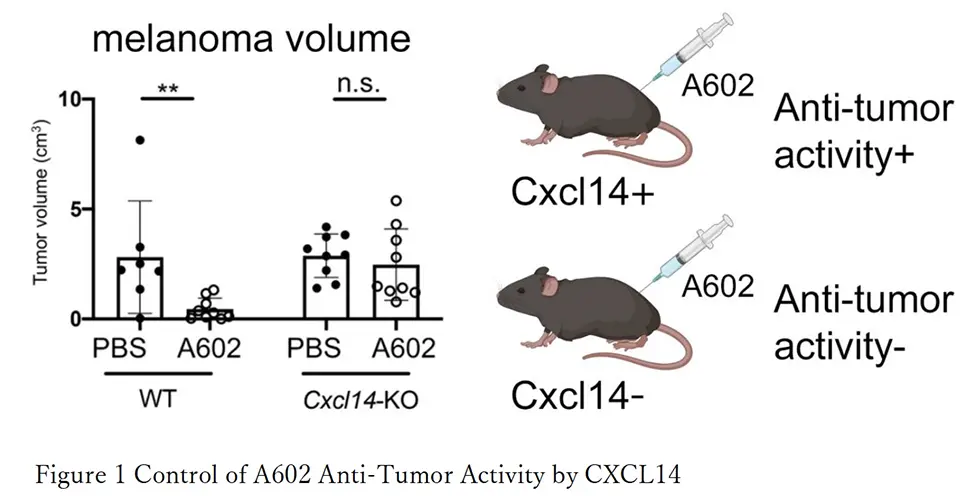Stem Cell Project in our institute have elucidated that the cancer immuno-inducing activity of DNA called CpG ODN is due to its interaction with the chemokine CXCL14. This work is done by collaboration with SBI Biotech. In this study, we explored modified CpG DNA sequences called CpG ODN, which had previously shown immune-enhancing activity, to find those with stronger activity. The CpG ODN (A602) obtained demonstrated strong tumor-suppressive effects in mouse models of cancer types where conventional CpG ODN showed less anti-cancer activity. Previously, the Stem Cell Project had discovered that chemokine CXCL14 binds to CpG DNA and enhances its uptake into dendritic cells (Note 1), activating the receptor TLR9 and significantly boosting innate immunity (Note 2) and inflammatory responses. Therefore, we investigated the involvement of CXCL14 in the anti-tumor activity of A602, finding that CXCL14 greatly enhances cytokine induction related to anti-tumor immunity by A602, and that A602's anti-tumor activity is lost in Cxcl14-KO mice. These results suggest a new mechanism of action for DNA with anti-cancer activity and are expected to lead to the identification of patients for whom CpG ODN’s anti-tumor activity is effective and to the elucidation of molecular mechanisms for stronger effects. These findings have been published in the international academic journal "Journal of Immunology" (online edition) on May 23rd, 2025.
Chemokines (Note 3) are secreted proteins that promote the migration of cells, known to contribute to inflammatory responses by attracting leukocytes. In addition to the common functions of these chemokines, in 2017, the Stem Cell Project discovered a new function where CXCL14, a type of chemokine, binds to CpG DNA (Note 4), which is abundant in bacterial DNA, enhances its uptake into dendritic cells (Note 1) and significantly boosts innate immunity (Note 2) and inflammatory responses through the activation of its receptor TLR9. Meanwhile, focusing on the immune-activating ability of CpG DNA, attempts were made to induce anti-tumor immunity using synthetic DNA (CpG Oligonucleotide: CpG ODN) of about 20-25 bp length, but its effects were insufficient, preventing practical application.
To enhance the activity of CpG ODN, SBI Biotech modified the phosphorothioate (S) linkage commonly used to prevent degradation, partially reverting to the wild-type phosphate linkage. The modified CpG ODN (A602) demonstrated strong cytokine induction activity against human dendritic cell line, mouse macrophages, and dendritic cells. Additionally, A602 showed anti-tumor effects in various cancer models, including colon cancer, lymphoma, and skin cancer in mice. Tanegashima and Hara from the Stem Cell Project found that A602 binds with high affinity to CXCL14, enhancing its uptake into macrophages and dendritic cells and significantly boosting cytokine induction related to anti-tumor activity. To investigate the correlation between the anti-tumor activity of A602 and the complex formation with CXCL14, melanoma cells were transplanted into Cxcl14 knockout (KO) mice and the anti-tumor effect was studied. The anti-tumor effect of A602 disappeared in melanoma transplanted into Cxcl14-KO mice (mice lacking Cxcl14), revealing that the cooperative action with CXCL14 is essential for the anti-tumor effect of CpG ODN. These discoveries elucidate a new mechanism of action for DNA with anti-cancer activity and are expected to lead to the identification of patients for whom CpG ODN’s anti-tumor activity is effective and to the elucidation of molecular mechanisms for stronger effects.
